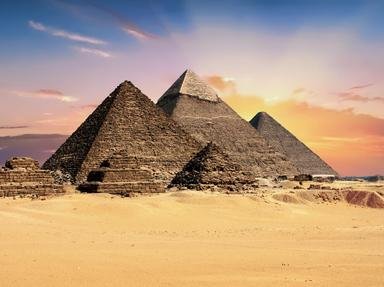Quiz Answer Key and Fun Facts
1. The Great Pyramid of Cheops: Built around 2560 B.C., the pyramid was designed for the fourth dynasty Pharaoh Cheops. What artefact, useful in getting Cheops to the afterlife, was discovered within the pyramid in 1954?
2. The Hanging Gardens of Babylon: Thought to have been built for his wife/concubine Amytis to remind her of her homeland, the Hanging Gardens are said to be the work of which ancient King?
3. The Statue Of Zeus at Olympia: housed inside the Temple of Zeus, the statue of the seated deity was criticised by the Greek geographer Strabo for being out of proportion. What was his reasoning behind this criticism?
4. The Temple of Artemis at Ephesus: In 356 B.C. the Temple of Artemis was burnt to the ground by a nobody called Herostratus who was seeking a claim to fame to be remembered by. Legend has it that Artemis could not be there to protect the temple built in her honour as she was watching over the birth of who that very same night?
5. The Mausoleum at Halicarnassus: At the order of Artemisia as a memorial to her husband Mausolus, the Mausoleum is the only wonder to be built by a woman. Apart from being husband and wife, what other relationship existed between Mausolus and Artemisia?
6. The Colossus of Rhodes: Designed by Chares of Lindos, a city of Rhodes, the Colossus stood at 110 feet tall. It has been said that during the construction, a minor flaw in the design was pointed out to Chares. What was his reaction to this criticism?
7. The Pharos of Alexandria: Standing at a total height of around 384 feet, at the time of its completion the lighthouse was the second tallest building in the world. Which one of its fellow wonders was the Pharos of Alexandria runner up to?
8. The Great Wall of China: Figures given for the length of the wall vary between 1,500 - 4,000 miles. This is mostly due to archaeologists not being sure of which sections should be counted. Let's all try to agree on this oft asked question; can you really see the Great Wall of China from the moon?
9. The Colosseum: Although commonly known by its one name moniker, the actual name of the Colosseum is the Flavian Amphitheatre. This title contains the family name of which emperor, responsible for the construction of the Colosseum?
10. The Taj Mahal: Begun and completed in the first half of the 17th century, the Taj Mahal was built by Mughal emperor Shah Jahan as a mausoleum for his third and favourite wife, Mumtaz Mahal. How did Mumtaz die?
11. Machu Picchu: Commonly referred to as the 'Lost City of the Incas', Machu Picchu is located more than 2,400 metres above sea level. When translated, what does Machu Picchu mean?
12. Chichen-Itza: Located on the Yucatan Peninsula of Mexico, the city of Chichen-Itza was built by the people of which civilization?
13. Petra: Like so many places in this part of the world, the city of Petra has a rich and varied history. Which Middle Eastern country would you have to go to in order to view this city carved out of rock?
14. Christ The Redeemer: Located atop the Corcovado mountain in the Tijuca Forest National Park, the statue of Christ The Redeemer overlooks Rio de Janeiro with its arms in what position?
15. The seven recipients of the title New Wonders of the World were announced in 2007 in Lisbon, Portugal. What was the exact date that this took place?
Source: Author
Aussiedrongo
This quiz was reviewed by FunTrivia editor
trident before going online.
Any errors found in FunTrivia content are routinely corrected through our feedback system.
